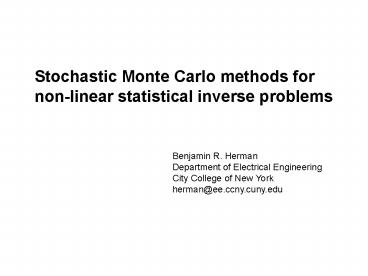Stochastic Monte Carlo methods for - PowerPoint PPT Presentation
1 / 16
Title:
Stochastic Monte Carlo methods for
Description:
Stochastic Monte Carlo methods for. non-linear statistical inverse problems. Benjamin R. Herman ... the maximum a posteriori inverse (Blue) and the Ensemble ... – PowerPoint PPT presentation
Number of Views:36
Avg rating:3.0/5.0
Title: Stochastic Monte Carlo methods for
1
Stochastic Monte Carlo methods for non-linear
statistical inverse problems
Benjamin R. Herman Department of Electrical
Engineering City College of New
York herman_at_ee.ccny.cuny.edu
2
Overview
- Aerosol lidar system
- Retrieval of aerosol properties from lidar
measurements - Metropolis-Hastings algorithm for uncertainty
analysis - Techniques for its efficient implementation
3
CCNY Aerosol/Water vapor lidar
Transmits light at 1064, 532, and 355nm Detects
signals at transmitted wavelengths as well as two
wavelengths shifted from 355nm by Raman
scattering from N2 and H2O 1 Three wavelength
pulsed NdYAG Laser 2 Newtonian Telescope 3
Receiver optics and photo-detectors 4 Licel
transient recorder, analog and photon counting
4
Optical coefficients and lidar equations
Elastic lidar equation
Raman lidar equation
5
Multi-mode aerosol model and optical coefficients
Aerosol is modeled as being composed of different
constituents, each with a size distribution and
index of refraction
Optical coefficient dependency
Aerosol state vector
Refractive index
Volume concentration
Median Radius
Geometric standard deviation
6
Uncertainty analysis
Uncertainty is expressed in the form of a
posterior probability density function (PDF)
Estimated optical coefficients (retrieval results
from lidar signal processing)
Estimation error
How can uncertainty in the high dimension aerosol
model be understood to assess uncertainty of
aerosol properties?
7
Stochastic Monte Carlo
Sequence of Random Variables Tn with PDFs fn
Markov Chain
Stationary distributions
Begin with T0 and generate subsequent T according
to some K
Monte Carlo simulation
8
Metropolis-Hastings Algorithm
Designed so that a target distribution p(?) is
stationary
1) Generate candidate F given current outcome T
from a random number generator congruent with a
proposal distribution whose PDF is q(f?)
3) If F is not accepted then T is retained as the
next outcome
Initial distributions f0(?) will converge to
p(?) with only lose requirements of the proposal
distribution. Its choice affects the rate of
convergence but generally not the stationary
distribution.
- Types of Proposal Distributions
- Random walk generators
- Independent generators
9
Implementation
- Ensemble of parallel chains starting from an
initial distribution - Random walk generation for first several links
- Ensemble is analyzed partway along the chain,
clusters are determined and used to form a hybrid
proposal distribution
Hybrid proposal distribution Randomly choose walk
generation or generation from a distribution
corresponding to one of the clusters, thereby
allowing teleportation between regions. This
aspect is essential for dealing with multiple
local maxima in the posterior PDF.
10
Ensemble evolution animation
Example in a reduced single mode aerosol size
distribution The target distribution PDF is only
a function of median radius and geometric
standard deviation
11
Speeding convergence by initial resampling
- Ensemble members are not getting represented by
clusters - Results in tendency not to teleport
Hybrid B also includes a small probability of
sampling from the initial distribution
12
Comparison with forward Monte Carlo analysis
Numerically integrated posterior cumulative
distribution functions (CDFs) (Black) and CDFs
estimated from the simple forward Monte Carlo
method applied using the maximum a posteriori
inverse (Blue) and the Ensemble
Metropolis-Hastings algorithm (Red).
13
Extension to bi-modal particle size distributions
Speeding convergence by fitting proposal PDF to
the target PDF
Multivariate Gaussian PDF
First derivative fitting
Second derivative fitting
Eigenvalue conditioning S must be positive
definite to be a valid covariance matrix. This
is not guaranteed if the target distribution is
not Gaussian, and so it is remedied through
eigenvector decomposition. Negative Eigenvalues
are set to an upper limit and S is recomposed.
14
Implementations
Acceptance rate is used for determining at which
link to cluster the ensemble to form the hybrid
proposal distribution
Full second order derivative fitting compared
with uncorrelated partially fitted random walk
generation
Higher acceptance probability with uncorrelated
random walk is due to scaling down the fitted
variance
15
Periodic re-hybridization to speed convergence
All ensemble members had been together since
link 500
Link 1000
Hybridization only once
After 10000 links there still remain some members
around a local maximum
16
Things to think about
- How to choose when to form the multi-component
independent generator from clusters - Can the independent generator be periodically
reformulated indefinitely while still maintaining
convergence to the target distribution - Which clustering method works best
- Is there an optimal compromise between random
walk with uncorrelated variance versus complete
fitting of all mixed derivatives































